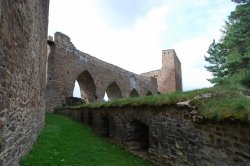Velhartice (hrad)
Hrad Velhartice můžete v průvodcích objevit také pod názvem hrad Buška z Velhartic, komorníka císaře a krále Karla IV. Originální gotický hrad najdete v překrásné šumavské krajině, samotné umístění i okolní lesy vytvářejí neopakovatelnou romantickou atmosféru. Mohutná stavba hradu se tyčí na skále nad říčkou Ostružnou, mezi městy Sušice a Klatovy.
Užitečné informace pro návštěvníky
Otevírací doba a vstupné
The tour of the castle begins with an audiovisual program
Right at the beginning of the tour you will watch a program about the construction and development of the castle. The tour continues with the castle farm and the premises of the Paradise Palace. Drawbridges and a stone bridge will also make an indelible impression on you. The Putna defense tower is also very interesting. In the chateau itself, you will see Renaissance interiors and you can get an idea of how an aristocratic family lived in the chateau. You will walk through common rooms, changing rooms and chambers, a ballroom, a games room, a dining room or a hunting hall. Part of the tour is free, in the forecourt you can visit the open-air museum of folk architecture.
Coronation jewels were also kept in Velhartice
Bušek from Velhartice was the first known owner of the castle. As the chamberlain of Charles IV. both Bušek and his son served. By marriage, the castle became the property of the lords of Hradec. During the Hussite wars, a tower was built on the castle to store coronation jewels. Different owners took turns at the castle in Bílá hora. During the violent re-Catholicization, Velhartice Castle belonged to the infamous Martin de Hoeff-Huert. He had a Renaissance palace built. Later, the castle served mainly economic purposes and fell into disrepair. Repairs in the romantic spirit began in the 19th century, after 1945 the castle became the property of the state and was gradually reconstructed.
There are various legends about the owners
Most legends about Velhartice Castle are described by the cruel actions of Martin de Hoeff - Huerty. One of them tells of the so-called Rainy Meadow ". Many subjects died during the plague. Three orphaned children from the cottage wanted to sell Huert a meadow so he wouldn't starve. Martin Huerta laughed at them at first, but then exchanged the meadow for a pot of porridge. Hungry and deceived children died of the plague, but the meadow could not be mowed - it always started to rain when mowing. Legend has it that it rains tears for cheated children.
Author: Helena Syslová
Velhartice (hrad) - zajímavosti
Prohlídka hradu začíná audiovizuálním pořadem
Hned na začátku prohlídky zhlédnete pořad o stavbě a vývoji hradu. Prohlídka pokračuje hradním hospodářstvím a prostorami Rajského paláce. Padací můstky i kamenný most na Vás také zapůsobí nesmazatelným dojmem. Velmi zajímavá je i obranná věž Putna. V samotných prostorách zámku uvidíte renesanční interiéry a můžete si udělat představu o tom, jak žila šlechtická rodina na zámku. Projdete společnými místnostmi, šatnami a komorami, tanečním sálem, hernou, jídelnou nebo loveckou chodbou. Část prohlídky je volná, v předhradí můžete navštívit i skanzen lidové architektury.
Na Velharticích byly uschovány i korunovační klenoty
Bušek z Velhartic byl prvním známým majitelem hradu. Jako komorník Karla IV. sloužil jak Bušek, tak jeho syn. Sňatkem se hrad stal majetkem pánů z Hradce. Za husitských válek byla na hradě postavena věž pro uschování korunovačních klenotů. Do Bílé hory se na hradě střídali různí majitelé. Za násilné rekatolizace patřil hrad Velhartice nechvalně známému Martinu de Hoeff – Huertovi. Ten nechal postavit renesanční palác. Později hrad sloužil hlavně hospodářským účelům a chátral. Opravy v romantickém duchu začaly v 19. století, po roce 1945 se hrad stal majetkem státu a byl postupně rekonstruován.
K majitelům se vztahují různé pověsti
Nejvíce pověstí o hradu Velhartice líčí kruté jednání Martina de Hoeff – Huerty. Jedna z nich vypráví o tzv. Deštivé louce“. Za dob moru umíralo mnoho poddaných. Tři osiřelé děti z chalupy chtěly prodat Huertovi louku, aby nezemřely hlady. Martin Huerta se jim nejdříve vysmál, ale pak louku vyměnil za hrnec kaše. Hladové a ošizené děti zemřely na mor, ale louku se nepodařilo sekat – při sekání vždy začalo pršet. Pověst říká, že prší slzy ošizených dětí.
Autor: Helena Syslová





























